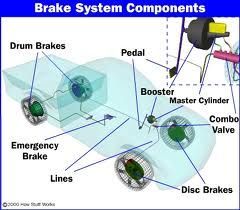
Brakes
By kicking down on the brake pedal, pressure is applied to the enclosed brake fluid by operating the master cylinder; the pressure is then uniformly transmitted through the brake lines / brake hoses to the brake cylinders of the wheel brakes.
Disc brakes and drum brakes are used as wheel brakes. The wheel brake cylinders or the brake calliper pistons create a clamping force which presses the brake pads against the rotating brake discs / brake drums. Friction occurs between brake pad and brake disc / brake drum, which reduces the number of rotations of the wheel and thereby ultimately the speed of the vehicle by raising the friction force between the wheel and the road surface. Disc brake Many years ago, the development of ever more powerful and quicker automobiles already prompted manufacturers to install disk brakes. Today this decision is still considered to be an important step in increasing vehicle safety. Stable braking behaviour and high load capacity of the brakes, as well as the lower loss of effectiveness under long term strain, are the essential advantages of disc brakes in comparison to drum brakes. Furthermore, we should also mention the automatic adjusting and self-cleaning effect. As a rule, brake discs are easy to service, brake pads can be changed without any problems.
Disc brake pads
Full braking and permanent strain on the brakes place high demands on brake pads. Damaged pads or quality deficiencies extend the braking distance. Bad quality combined with permanent strain, for example long downhill travel, can lead to so-called fading: The brake effect decreases at high temperatures which are especially caused by bad heat dissipation. The pads run hot, the driver must operate the brake pedal ever harder to attain a sufficient braking effect.
